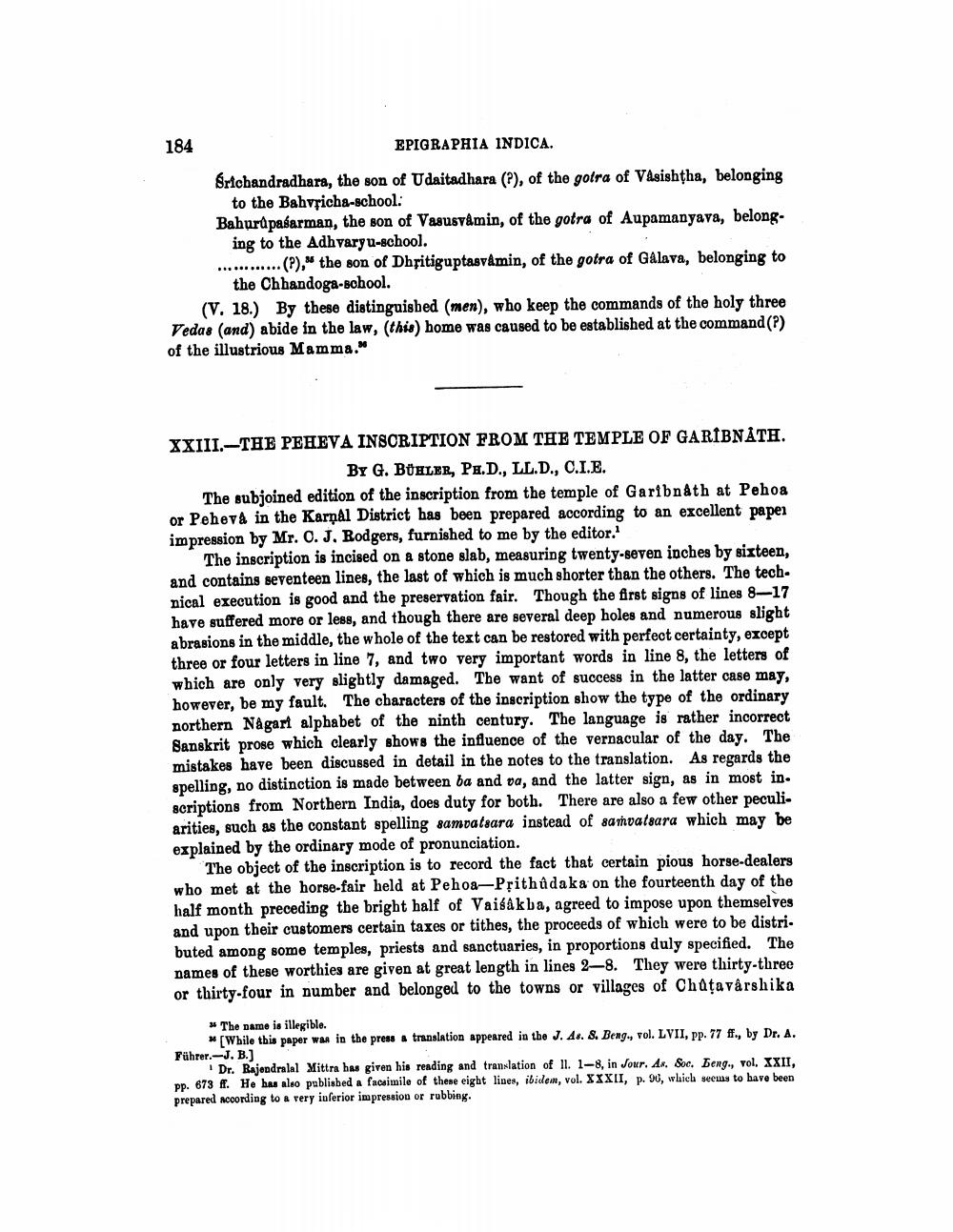________________
184
EPIGRAPHIA INDICA.
Srichandradhara, the son of Udaitadhara (R), of the gotra of Vasishtha, belonging
to the Bahvpicha-school: Bahuru pašarman, the son of Vasusvåmin, of the gotra of Aupamanyava, belong
ing to the Adhvaryu-school. ............(?)," the son of Dhfitiguptasvåmin, of the gotra of Galava, belonging to
the Chhandoga-school. (V. 18.) By these distinguisbed (men), who keep the commands of the holy three Vedas (and) abide in the law, (this) home was caused to be established at the command(?) of the illustrious Mamma."
XXIII.-THE PEHEVA INSCRIPTION FROM THE TEMPLE OF GARIBNÅTH.
BY G. BÜHLER, Ph.D., LL.D., C.I.E. The subjoined edition of the inscription from the temple of Garibnath at Pehoa or Peheva in the Karnal District has been prepared according to an excellent paper impression by Mr. O. J. Rodgers, furnished to me by the editor.
The inscription is incised on a stone slab, measuring twenty-seven inches by sixteen, and contains seventeen lines, the last of which is much shorter than the others. The tech. nical execution is good and the preservation fair. Though the first signs of lines 8-17 have suffered more or less, and though there are several deep holes and numerous slight abrasions in the middle, the whole of the text can be restored with perfect certainty, except three or four letters in line 7, and two very important words in line 8, the letters of which are only very slightly damaged. The want of success in the latter case may, however, be my fault. The characters of the inscription show the type of the ordinary northern Nagart alphabet of the ninth century. The language is rather incorrect Sanskrit prose which clearly shows the influence of the vernacular of the day. The mistakes have been discussed in detail in the notes to the translation. As regards the spelling, no distinction is made between ba and va, and the latter sign, as in most in. scriptions from Northern India, does duty for both. There are also a few other peculi. arities, such as the constant spelling samvatsara instead of samvatsara which may be explained by the ordinary mode of pronunciation.
The object of the inscription is to record the fact that certain pious horse-dealers who met at the horse-fair held at Pehoa-Prithûdaka on the fourteenth day of the half month preceding the bright half of Vaisakba, agreed to impose upon themselves and upon their customers certain taxes or tithes, the proceeds of which were to be distri. buted among some temples, priests and sanctuaries, in proportions duly specified. The names of these worthies are given at great length in lines 2-8. They were thirty-three or thirty-four in number and belonged to the towns or villages of Chțavârshika
* The name is illegible.
*[While this paper was in the press translation appeared in the J. 16. 8. Beng., vol. LVII, pp. 77 ff., by Dr. A. Führer.-J. B.)
Dr. Rajendralal Mittra has given his reading and translation of 11. 1-8, in Jour. Ax. Soc. Deng., vol. XXII, pp. 673 ff. He has also publisbed a facsimile of these eight lines, ibidem, vol. XXXII, p. 90, whicla seems to have been prepared according to a very inferior impression or rubbing.




